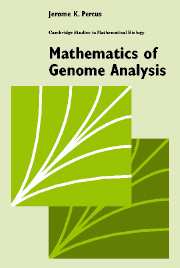Preface
Published online by Cambridge University Press: 04 December 2009
Summary
“What is life?” is a perennial question of transcendent importance that can be addressed at a bewildering set of levels. A quantitative scientist, met with such a question, will tend to adopt a reductionist attitude and first seek the discernible units of the system under study. These are, to be sure, molecular, but it has become clear only in recent decades that the “founder” molecules share the primary structure of linear sequences – in accord with a temporal sequence of construction – subsequent to which chemical binding as well as excision can both embed the sequence meaningfully in real space and create a much larger population of molecular species. At the level of sequences, this characterization is, not surprisingly, an oversimplification because, over-whelmingly, the construction process of a life form proceeds via the linear sequences of DNA, then of RNA, then of protein, on the way to an explosion of types of molecular species. The founder population of this subsequence is certainly DNA, which is the principal focus of our study, but not – from an informational viewpoint – to the exclusion of the proteins that serve as ubiquitous enzymes, as well as messengers and structural elements; the fascinating story of RNA will be referred to only obliquely.
That the molecules we have to deal with are fundamentally describable as ordered linear sequences is a great blessing to the quantitatively attuned. Methods of statistical physics are particularly adept at treating such entities, and information science – the implied context of the bulk of our considerations – is also most comfortable with these objects.
- Type
- Chapter
- Information
- Mathematics of Genome Analysis , pp. ix - xPublisher: Cambridge University PressPrint publication year: 2001



